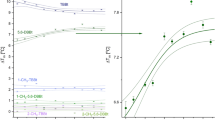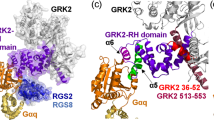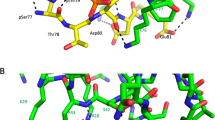Abstract
Guanine nucleotide exchange factors in the Dbl family activate Rho GTPases by accelerating dissociation of bound GDP, promoting acquisition of the GTP-bound state. Dbl proteins possess a ∼200 residue catalytic Dbl-homology (DH) domain, that is arranged in tandem with a C-terminal pleckstrin homology (PH) domain in nearly all cases. Here we report the solution structure of the DH domain of human PAK-interacting exchange protein (βPIX). The domain is composed of 11 α-helices that form a flattened, elongated bundle. The structure explains a large body of mutagenesis data, which, along with sequence comparisons, identify the GTPase interaction site as a surface formed by three conserved helices near the center of one face of the domain. Proximity of the site to the DH C-terminus suggests a means by which PH-ligand interactions may be coupled to DH-GTPase interactions to regulate signaling through the Dbl proteins in vivo.
This is a preview of subscription content, access via your institution
Access options
Subscribe to this journal
Receive 12 print issues and online access
$189.00 per year
only $15.75 per issue
Buy this article
- Purchase on Springer Link
- Instant access to full article PDF
Prices may be subject to local taxes which are calculated during checkout






Similar content being viewed by others
References
Hall, A. Rho GTPases and the actin cytoskeleton. Science 279, 509–514 (1998).
Kozma, R., Ahmed, S., Best, A. & Lim, L. The Ras-related protein Cdc42Hs and bradykinin promote formation of peripheral actin microspikes and filopodia in Swiss 3T3 fibroblasts. Mol. Cell Biol 15, 1942–1952 (1995).
Nobes, C. D. & Hall, A. Rho, rac, and cdc42 GTPases regulate the assembly of multimolecular focal complexes associated with actin stress fibers, lamellipodia, and filopodia. Cell 81, 53–62 (1995).
Ridley, A. J., Paterson, H. F., Johnstone, C. L., Diekmann, D. & Hall, A. The small GTP-sinding protein rac regulates growth factor-induced membrane ruffling. Cell 70, 401–410 (1992).
Ridley, A. J. & Hall, A. The small GTP-binding protein rho regulates the assembly of focal adhesions and actin stress fibres in response to growth factors. Cell 70, 389–399 (1992).
Olson, M. F., Ashworth, A. & Hall, A. An essential role for Rho, Rac, and Cdc42 GTPases in cell cycle progression through G1. Science 269, 1270–1272 (1995).
Minden, A., Lin, A., Claret, F. X., Abo, A. & Karin, M. Selective activation of the JNK signaling cascade and c-Jun transcriptional activity by the small GTPases Rac and Cdc42Hs. Cell 81, 1147–1157 (1995).
Coso, O.A. et al. The small GTP-binding proteins Rac1 and Cdc42 regulate the activity of the JNK/SAPK signaling pathway. Cell 81, 1137–1146 (1995).
Bagrodia, S., Derijard, B., Davis, R. J. & Cerione, R. A. Cdc42 and PAK-mediated signaling leads to Jun kinase and p38 mitogen- activated protein kinase activation. J. Biol. Chem. 270, 27995–27998 (1995).
Hill, C. S., Wynne, J. & Treisman, R. The Rho family GTPases RhoA, Rac1, and CDC42Hs regulate transcriptional activation by SRF. Cell 81, 1159–1170 (1995).
Qiu, R. G., Chen, J., Kirn, D., McCormick, F. & Symons, M. An essential role for Rac in Ras transformation. Nature 374, 457–459 ( 1995).
Michiels, F., Habets, G. G., Stam, J. C., van der Kammen, R. A. & Collard, J. G. A role for Rac in Tiam1-induced membrane ruffling and invasion. Nature 375, 338–340 (1995).
Pasteris, N. G. et al. Isolation and characterization of the faciogenital dysplasia (Aarskog-Scott syndrome) gene: a putative Rho/Rac guanine nucleotide exchange factor. Cell 79, 669–678 (1994).
Billuart, P. et al. Oligophrenin-1 encodes a rhoGAP protein involved in X-linked mental retardation. Nature 392, 923– 926 (1998).
Bourne, H. R., Sanders, D. A. & McCormick, F. The GTPase superfamily: a conserved switch for diverse cell functions. Nature 348, 125– 131 (1990).
Bokoch, G. M. & Der, C. J. Emerging concepts in the Ras superfamily of GTP-binding proteins. FASEB J. 7, 750 –759 (1993).
Boguski, M. & McCormick, F. Proteins regulating Ras and its relatives. Nature 366, 643– 654 (1993).
Cerione, R. A. & Zheng, Y. The Dbl family of oncogenes. Curr Opin Cell Biol 8, 216– 222 (1996).
Zheng, Y., Zangrilli, D., Cerione, R. A. & Eva, A. The pleckstrin homology domain mediates transformation by oncogenic dbl through specific intracellular targeting. J Biol Chem 271, 19017–19020 (1996).
Hart, M. J. et al. Cellular transformation and guanine nucleotide exchange activity are catalyzed by a common domain on the dbl oncogene product. J. Biol. Chem. 269, 62–65 (1994).
Chuang, T. H. et al. Abr and Bcr are multifunctional regulators of the Rho GTP-binding protein family. Proc. Natl. Acad. Sci. USA 92, 10282–10286 (1995).
Zheng, Y. et al. The faciogenital dysplasia gene product FGD1 functions as a Cdc42Hs- specific guanine-nucleotide exchange factor. J. Biol. Chem. 271, 33169–33172 (1996).
Steven, R. et al. UNC-73 activates the Rac GTPase and is required for cell and growth cone migrations in C. elegans. Cell 92 , 785–795 (1998).
Horii, Y., Beeler, J. F., Sakaguchi, K., Tachibana, M. & Miki, T. A novel oncogene, ost, encodes a guanine nucleotide exchange factor that potentially links Rho and Rac signaling pathways. EMBO J. 13, 4776–4786 (1994).
Miki, T., Smith, C. L., Long, J. E., Eva, A. & Fleming, T. P. Oncogene ect2 is related to regulators of small GTP-binding proteins [published erratum appears in Nature 364, 737]. Nature 362, 462–465 (1993).
Glaven, J. A., Whitehead, I. P., Nomanbhoy, T., Kay, R. & Cerione, R. A. Lfc and Lsc oncoproteins represent two new guanine nucleotide exchange factors for the Rho GTP-binding protein. J Biol Chem 271, 27374– 27381 (1996).
Klebe, C., Prinz, H., Wittinghofer, A. & Goody, R. S. The kinetic mechanism of Ran-nucleotide exchange catalyzed by RCC1. Biochemistry 34, 12543–12552 (1995).
Pawson, T. Protein modules and signalling networks. Nature 373 , 573–580 (1995).
Musacchio, A., Gibson, T., Rice, P., Thompson, J. & Saraste, M. The PH domain: a common piece in the structural patchwork of signalling proteins. Trends Biochem. Sci. 18, 343–348 (1993).
Bagrodia, S., Taylor, S. J., Jordon, K. A., Van Aelst, L. & Cerione, R. A. A novel regulator of p21-activated kinases. J. Biol. Chem. 273, 23633– 23636 (1998).
Manser, E. et al. PAK kinases are directly coupled to the PIX family of nucleotide exchange factors. Mol. Cell 1, 183– 192 (1998).
Logan, T. M., Olejniczak, E. T., Xu, R. X. & Fesik, S. W. A general method for assigning NMR spectra of denatured proteins using 3D HC(CO)NH-TOCSY triple resonance experiments. J. Biomol. NMR 3, 225–231 (1993).
Kay, L. E., Xu, G. Y., Singer, A. U., Muhandiram, D. R. & Forman-Kay, J. D. A gradient-enhanced HCCH-TOCSY experiment for recording side-chain proton and carbon-13 correlations in water samples of proteins. J. Magn. Reson. Ser. B 101, 333– 337 (1993).
Rosen, M. et al. Selective methyl group protonation of perdeuterated proteins. J. Mol. Biol. 263, 627– 636 (1996).
Gardner, K. & Kay, L. Production and incorporation of 15N, 13C, 2H(1H-1 methyl) isoleucine into proteins for multidimensional NMR studies. J. Am. Chem. Soc. 119, 7599–7600 (1997).
Gardner, K., Rosen, M. & Kay, L. Global folds of highly deuterated, methyl potonated proteins by multidimensional NMR. Biochemistry 36, 1389– 1401 (1997).
Metzler, W., Whittekind, M., Goldfarb, V., Mueller, L. & Farmer, B. Incorporation of 1H/13C/15N-(IIe, Leu, Val) into perdeuterated, 15N-labeled protein: potential in structure determination of large proteins by NMR. J. Am. Chem. Soc. 118, 6800–6801 (1996).
Smith, B. et al. An approach to global fold determination using limited NMR data from larger proteins selectively protonated at specific residues. J. Biomol. NMR 8, 360–368 (1996).
Gardner, K., Konrat, R., Rosen, M. & Kay, L. A (H)C(CO)NH-TOCSY pulse scheme for sequential assignment of protonated methyl groups in otherwise deuterated 15N, 13C labeled proteins. J. Biomol. NMR 8, 351–356 (1996).
Wuthrich, K. NMR of proteins and nucleic acids (John Wiley & Sons, New York; 1986).
Zwahlen, C., Vincent, S. J. F., Gardner, K. H. & Kay, L. E. Significantly improved resolution for NOE correlations from valine and isoleucine (Cg2) methyl groups in 15N,13C- and 15N, 13C, 2H-labeled proteins. J. Am. Chem. Soc. 120, 4825–4831 (1998).
Wishart, D. S. & Sykes, B. D. The 13C chemical-shift index: a simple method for the identification of protein secondary structure using 13C chemical-shift data. J. Biomol. NMR 4, 171– 180 (1994).
Nilges, M., Macias, M. J., O'Donoghue, S. I. & Oschkinat, H. Automated NOESY interpretation with ambiguous distance restraints: the refined NMR solution structure of the pleckstrin homology domain from beta-spectrin. J. Mol. Biol. 269, 408– 422 (1997).
Holm, L. & Sander, C. Protein structure comparison by alignment of distance matrices. J. Mol. Biol. 233, 123–138 (1993).
Yu, H. & Schreiber, S. L. Structure of guanine-nucleotide-exchange factor human Mss4 and identification of its Rab-interacting surface. Nature 376, 788–791 ( 1995).
Mossessova, E., Gulbis, J. M. & Goldberg, J. Structure of the guanine nucleotdie exchange factor of human ARNO and analysis of the interaction with ARF GTPase. Cell 92, 415–423 ( 1998).
Cherfils, J. et al. Structure of the Sec7 domain of the Arf exchange factor ARNO. Nature 392, 101–104 (1998).
Renoult, L. et al. The 1.7 A crystal structure of the regulator of chromosome condensation (RCC1) reveals a seven-bladed propeller. Nature 392, 97–101 (1998).
Boriack-Sjodin, P. A., Margarit, S. M., Bar-Sagi, D. & Kuriyan, J. The structural basis of the activation of Ras by SOS. Nature 394, 337–343 (1998).
Pervushin, K., Riek, R., Wider, G. & Wuthrich, K. Attenuated T2 relaxation by mutual cancellation of dipole-dipole coupling and chemical shift anisotropy indicates an avenue to NMR structures of very large biological macromolecules in solution. Proc. Natl. Acad. Sci. USA 94, 12366–12371 (1997).
Crespo, P. et al. Rac1 dependent stimulation of the JNK/SAPK signaling pathway by Vav. Oncogene 13, 455– 462 (1996).
Miyamoto, S. et al. A DBL-homologous region of the yeast CLS4/CDC24 gene product is important for Ca(2+)-modulated bud assembly. Biochem. Biophys. Res. Comm. 181, 604–610 (1991).
Ron, D. et al. New Biologist 3, 372– 379 (1991).
Zheng, J. et al. The solution structure of the pleckstrin homology domain of human SOS1. J. Biol. Chem. 272, 30340– 30344 (1997).
Koshiba, S. et al. The solution structure of the pleckstrin homology domain of mouse son-of-sevenless 1 (mSos1). J. Mol. Biol. 269 , 579–591 (1997).
Nimnual, A. S., Yatsula, B. A. & Bar-Sagi, D. Coupling of Ras and Rac guanosine triphosphatases through the Ras exchanger Sos. Science 279, 560– 563 (1998).
Olson, M. F., Sterpetti, P., Nagata, K., Toksoz, D. & Hall, A. Distinct roles for DH and PH domains in the Lbc oncogene. Oncogene 15, 2827– 2831 (1997).
Whitehead, I., Kirk, H., Tognon, C., Trigo-Gonzalez, G. & Kay, R. Expression cloning of lfc, a novel oncogene with structural similarities to guanine nucleotide exchange factors and to the regulatory region of protein kinase C. J. Biol. Chem. 270, 18388–18395 (1995).
Lenzen, C., Cool, R. H., Prinz, H., Kuhlmann, J. & Wittinghofer, A. Kinetic analysis by fluorescence of the interaction between Ras and the catalytic domain of the guanine nucleotide exchange factor Cdc25Mm. Biochemistry 37, 7420– 7430 (1998).
Goldberg, J. Structural basis for activation of ARF GTPase: Mechanisms of guanine nucleotide exchange and GTP-myristoyl switching. Cell, 95, 273–248 (1998).
Beraud-Dufour, S. et al. A glutamic finger in the guanine nucleotide exchange factor ARNO displaces Mg2+ and the beta-phosphate to destabilize GDP on ARF1. EMBO J. 17, 3651–3659 ( 1998).
Li, R. & Zheng, Y. Residues of the Rho family GTPases Rho and Cdc42 that specify sensitivity to Dbl-like guanine nucleotide exchange factors. J. Biol. Chem. 272, 4671– 4679 (1997).
Soisson, S. M., Nimnual, A. S., Uy, M., Bar-Sagi, D. & Kuriyan, J. Crystal structure of the Dbl and pleckstrin homology domains from the human son of sevenless protein. Cell 95, 259–268 (1998).
Liu, X. et al. NMR structure and mutagenesis of the N-terminal Dbl homology domain of the nucleotide exchange factor trio. Cell 95, 269–277 (1998).
Zheng, Y., Cerione, R. & Bender, A. Control of the yeast bud-site assembly GTPase Cdc42. Catalysis of guanine nucleotide exchange by Cdc24 and stimulation of GTPase activity by Bem3. J. Biol. Chem. 269, 2369 –2372 (1994).
Delaglio, F. et al. NMRPipe: a multidimensional spectral processing system based on UNIX pipes. J. Biomol. NMR 6, 277– 293 (1995).
Johnson, B. A. & Blevins, R. A. NMR View: a computer program for the visualization and analysis of NMR data. J. Biomol. NMR 4, 603–614 (1994).
Yamazaki, T., Lee, W., Aerosmith, C., Muhandiriam, D. & Kay, L. A suite of tiple resonance NMR experiments for the backbone assignment of 15N, 13C, 2H labeled proteins with high sensitivity. J. Am. Chem. Soc. 116 , 11655–11666 (1994).
Muhandiram, D. R. & Kay, L. E. Gradient-enhanced triple-resonance three-dimensional NMR experiments with improved sensitivity. J. Magn. Reson. Ser. B 103, 203– 216 (1994).
Kay, L. E., Y., X. G. & Yamazaki, T. Enhanced-sensitivity triple-resonance spectroscopy with minimal H2O Saturation. J. Magn. Reson. Ser. A 109, 129–133 ( 1994).
Kay, L. E., Ikura, M., Tschudin, R. & Bax, A. Three dimensional triple-resonance NMR spectroscopy of isotopically enriched proteins. J. Magn. Reson. 89, 496–514 (1990).
Matsuo, H., Kupce, E., Li, H. & Wagner, G. Use of Selective C alpha pulses for improvement of HN(CA)CO-D and HN(COCA)NH-D experiments. J. Magn. Reson. Ser. B 111, 194– 198 (1996).
Clubb, R. T., Thanabal, V. & Wagner, G. A new 3D HN(CA)HA experiment for obtaining fingerprint HN -Ha cross peaks in 15N- and 13C-labeled proteins. J. Biomol. NMR 2, 203–210 (1992).
Grzesiek, S. & Bax, A. Correlating backbone amide and side chain resonances in larger proteins by multiple relayed triple resonance NMR. J. Am. Chem. Soc. 114, 6291– 6293 (1992).
Palmer, A. G. I., Cavanagh, J., Byrd, R. A. & Rance, M. Sensitivity improvement in three-dimensional heteronuclear correlation NMR spectroscopy. J. Magn. Reson. 96, 416– 424 (1992).
Neri, D., Szyperski, T., Otting, G., Senn, H. & Wuthrich, K. Stereospecific nuclear magnetic resonance assignments of the methyl groups of valine and leucine in the DNA-binding domain of the 434 repressor by biosynthetically directed fractional 13C labeling. Biochemistry 28, 7510 –7516 (1989).
Brunger, A. T. Crystallography and NMR system. Acta Crystallogr. D54 , 905–921 (1998).
Brünger, A. T. X-PLOR manual (Yale University, New Haven, Connecticut; 1993).
Laskowski, R. A., Rullmannn, J. A., MacArthur, M. W., Kaptein, R. & Thornton, J. M. AQUA and PROCHECK-NMR: programs for checking the quality of protein structures solved by NMR. J. Biomol. NMR 8, 477–486 (1996).
Carson, M. J. Ribbons 2.0. J. Appl. Crystallogr. 24, 958 –961 (1991).
Nicholls, A., Sharp, K. A. & Honig, B. Protein folding and association: insights from the interfacial and thermodynamic properties of hydrocarbons. Struct. Funct. Genet. 11, 281–296 ( 1991).
Acknowledgements
We thank Y. Min Chook and J. Goldberg for discussion and critical reading of the manuscript; J.Goldberg and S. Bagrodia and R. Cerione for communicating results prior to publication; L. Kay for generously providing many of the NMR pulse sequences used in this study; M. Clore for advice; A. Majumdar and Y. Gosser for assistance with NMR data acquisition; J. Hubbard for computer system support and S. Freihaut for expert administrative assistance. B.A. is supported by a grant from the U.S. Army Breast Cancer Program. M.K.R. gratefully acknowledges support from the National Institutes of Health (PECASE program), Arnold and Mabel Beckman Foundation and Sidney Kimmel Foundation for Cancer Research.
Author information
Authors and Affiliations
Corresponding author
Rights and permissions
About this article
Cite this article
Aghazadeh, B., Zhu, K., Kubiseski, T. et al. Structure and mutagenesis of the Dbl homology domain. Nat Struct Mol Biol 5, 1098–1107 (1998). https://doi.org/10.1038/4209
Received:
Accepted:
Issue Date:
DOI: https://doi.org/10.1038/4209
This article is cited by
-
The Rho-GEF PIX-1 directs assembly or stability of lateral attachment structures between muscle cells
Nature Communications (2020)
-
Structural insights into host GTPase isoform selection by a family of bacterial GEF mimics
Nature Structural & Molecular Biology (2009)
-
Investigation of the utility of selective methyl protonation for determination of membrane protein structures
Journal of Biomolecular NMR (2008)
-
A new interaction between Abi-1 and βPIX involved in PDGF-activated actin cytoskeleton reorganisation
Cell Research (2006)
-
GEF means go: turning on RHO GTPases with guanine nucleotide-exchange factors
Nature Reviews Molecular Cell Biology (2005)



